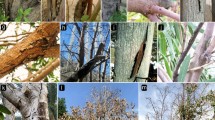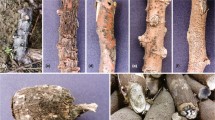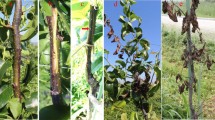Abstract
During the study of fungal pathogens associated with ornamental plants in Kerman province, southeastern Iran, a serious yellowing and decline symptom was observed on English ivy (Hedera helix L.) in some landscape areas. In order to identify the disease-causing agents samples were collected from infected plants exhibiting yellowing, wilting, reduced growth of shoots, foliage necrosis as well as crown and root rot. Fungal isolations were made from the roots, crowns and stems of symptomatic plants, as well as fruiting bodies formed on the surface of affected root and crown parts, onto potato dextrose agar (PDA). In this work, 54 Botryosphaeriaceae isolates were obtained from infected English Ivy plants. According to morphological characteristics and DNA sequence data obtained from the rDNA-ITS and translation elongation factor 1-α (tef-1α) gene, these isolates were identified as Neofusicoccum parvum, Botryosphaeria dothidea and Diplodia seriata. Pathogenicity tests were confirmed by inoculating potted English ivy plants. Inoculated plants showed wilting, black crown and root rot and wood discoloration within 60 days after inoculation. Neofusicoccum parvum being the most virulence species based on the length of vascular necrosis in the wood. Neofusicoccum parvum and D. seriata are reported here confirmed for the first time on English ivy. This is also the first record of B. dothidea on this host in Iran and outside China.



Similar content being viewed by others
References
Abdollahzadeh J, Zare R, Phillips AJL (2013) Phylogeny and taxonomy of Botryosphaeria and Neofusicoccum species in Iran, with description of Botryosphaeria scharifii sp. nov. Mycologia 105:210–220
Adesemoye AO, Mayorquin JS, Wang DH, Twizeyimana M, Lynch SC, Eskalen A (2014) Identification of species of Botryosphaeriaceae causing bot gummosis in citrus in California. Plant Dis 98:55–61
Alves A, Correia A, Luque J, Phillips AJL (2004) Botryosphaeria corticola, sp. nov. on Quercus species, with notes and description of Botryosphaeria stevensii and its anamorph, Diplodia mutila. Mycologia 96:598–613
Alves A, Correia A, Phillips AJL (2006) Multi-gene genealogies and morphological data support Diplodia cupressi sp. nov., previously recognized as D. pinea f. sp. cupressi, as a distinct species. Fungal Diver 23:1–15
Alves A, Linaldeddu BT, Deidda A, Scanu B, Phillips AJL (2014) The complex of Diplodia species associated with Fraxinus and some other woody hosts in Italy and Portugal. Fungal Diver 67:143–156
Ariyawansa H, Hyde KD, Liu JK, Wu SP, Liu ZY (2016) Additions to Karst Fungi 1: Botryosphaeria minutispermatia sp. nov., from Guizhou Province, China. Phytotaxa 275:35–44
Begoude BAD, Slippers B, Wingfield MJ, Roux J (2011) The pathogenic potential of endophytic Botryosphaeriaceous fungi on Terminalia species in Cameroon. Forest Pathol 41:281–292
Berraf–Tebbal A, Guerreiro MA, Phillips AJL (2014) Phylogeny of Neofusicoccum species associated with grapevine trunk diseases in Algeria, with description of Neofusicoccum algeriense sp. nov. Phytopathol Mediterr 53:416−427
Billones-Baajeins R, Jones EE, Ridgway HJ, Jaspers MV (2014) Susceptibility of common rootstock and scion grapevine varieties in New Zealand to Botryosphaeriaceae species. Australas Plant Pathol 43:25–31
Carbone I, Kohn LM (1999) A method for designing primer sets for speciation studies in filamentous ascomycetes. Mycologia 91:553–556
Chen SF, Pavlic D, Roux J, Slippers B, Xie YJ, Wingfield MJ, Zhou XD (2011) Characterization of Botryosphaeriaceae from plantation-grown Eucalyptus species in South China. Plant Pathol 60:739–751
Claudius-Cole AO (2018) Lasiodiplodia theobromae in the root rot disease complex of rice. J Rice Res 6:197
Custódio FA, Machado AR, Soares DJ, Pereira OL (2018) Lasiodiplodia hormozganensis causing basal stem rot on Ricinus communis in Brazil. Australas Plant Dis Notes 13:25
de Wet J, Burgess T, Slippers B, Presig O, Wingfield BD, Wingfield MJ (2003) Multiple gene genealogies and microsatellite markers reflect relationships between morphotypes of Sphaeropsis sapinea and identify a new species of Diplodia. Mycol Rese 107:557–566
Dissanayake AJ, Phillips AJL, Li XH, Hyde KD (2016) Botryosphaeriaceae: Current status of genera and species. Mycosphere 7:1001–1073
Duke JA (2002) Handbook of medicinal herbs, 2nd edn. CRC Press, Boca Raton, p 412
Epstein L, Sukhwinder K, VanderGheynst JS (2008) Botryosphaeria-related dieback and control investigated in noncoastal California grapevines. Calif Agr 62:161–166
Espargham N, Mohammadi H, Gramaje (2020) A survey of trunk disease pathogens within citrus trees in Iran. Plants 9:754. https://doi.org/10.3390/plants9060754
Farr DF, Rossman AY (2021) Fungal Databases, U.S. National Fungus Collections, ARS, USDA. Retrieved March 29, 2021, from https://nt.ars-grin.gov/fungaldatabases
Gerin D, Dongiovanni C, De Miccolis Angelini RM, Pollastro S, Faretra F (2018) First report of Macrophomina phaseolina causing crown and root rot on strawberry in Italy. Plant Dis 102(9):1857
Ghasemi-Sardareh R, Mohammadi H (2020) Characterization and pathogenicity of fungal trunk pathogens associated with declining of neem (Azadirachta indica A. Juss) trees in Iran. J Plant Pathol 102:1159–1171
Grand LF (1985) North Carolina Plant Disease Index. North Carolina Agric Res Serv Techn Bull 240:1–157
Grasso FM, Granata G (2010) First report of Botryosphaeria dothidea assotiated with dieback of aspen (Populus tremula) in Italy. New Dis Rep 20:28
Green AF, Ramsey TS, Ramsey J (2011) Phylogeny and biogeography of ivies (Hedera spp., Araliaceae) a polyploidy complex of woody vines. Syst Bot 36:1114–1127
Grivet D, Petit R (2002) Phylogeography of the common ivy (Hedera sp.) in Europe: genetic differentiation through space and time. Mol Ecol 11:1351–1362
Hall T (2006) BioEdit 7.5.0.3. Department of Microbiology, North Carolina State University. http://www.mbio.ncsu.edu/BioEdit/Bioedit.html
Hashemi H, Mohammadi H (2016) Identification and characterization of fungi associated with internal wood lesions and decline disease of willow and poplar trees in Iran. Forest Pathol 46:341–352
Hashemi H, Mohammadi H, Abdollahzadeh J (2017) Symptoms and fungi associated with elm trees decline in Iran. Eur J For Res 136(5–6):857–879
Hooshyar H, Talari S, Feyzi F (2014) Therapeutic effects of Hedera helix alcoholic extract against cutaneous leishmaniasis caused by leishmania major in Balb/ c Mice. Jundishapur J Microb 7:e9432
Inderbitzin P, Bostock RM, Trouillas FP, Michailides TJ (2010) A six locus phylogeny reveals high species diversity in Botryosphaeriaceae from California almond. Mycologia 102:1350–1368
Jiao ZJ, Kan YC, Huang SL (2014) First report of dieback disease on cedars caused by Diplodia seriata in China. Plant Dis 98:1279
Kazemzadeh Chakusary M, Mohammadi H, Khodaparast SA (2019) Diversity and pathogenicity of Botryosphaeriaceae species on forest trees in the north of Iran. Eur J For Res 138:685–704
Kumar S, Stecher G, Li M, Knyaz C, Tamura K (2018) MEGA X: molecular evolutionary enetics analysis across computing platforms. Mol Biol Evol 5(6):1547–1549
Latha P, Prakasam V, Kamalakannan A, Gopalakrishnan C, Raguchander T, Paramathma M, Samiyappan R (2009) First report of Lasiodiplodia theobromae (Pat.) Griffon & Maubl causing root rot and collar rot disease of physic nut (Jatropha curcas L.) in India. Australas Plant Dis Notes 4:19–20
Laveau C, Letouze A, Louvet G, Bastien S, Guerin-Dubrana L (2009) Differential aggressiveness of fungi implicated in esca and associated diseases of grapevine in France. Phytopathol Mediterr 48:32–46
Linaldeddu BT, Franceschini A, Alves A, Phillips AJL (2013) Diplodia quercivora sp. nov.: a new species of Diplodia found on declining Quercus canariensis trees in Tunisia. Mycologia 105(5):1266–1274
Liu JK, Phookamsak R, Doilom M, Wikee S, Li YM, Ariyawansa HA, Boonmee S, Chomnunti P, Dai DQ, Bhat JD, Romero AI, Zhuang WY, Monkai J, Jones EBG, Chukeatirote E, Ko TWK, Zhao YC, Wang Y, Hyde KD (2012) Towards a natural classification of Botryosphaeriales. Fungal Diver 57:149–210
Lopes A, Barradas C, Phillips AJL, Alves A (2017) Diversity and phylogeny of Neofusicoccum species occurring in forest and urban environments in Portugal. Mycosphere 7(7):906–920
Luque J, Martos S, Phillips AJL (2005) Botryosphaeria viticola sp. nov. on grapevines: a new species with a Dothiorella anamorph. Mycologia 97(5):1111–1121
Machado AR, Pinho DB, Pereira OL (2014) Phylogeny, identification and pathogenicity of the Botryosphaeriaceae associated with collar and root rot of the biofuel plant Jatropha curcas in Brazil, with a description of new species of Lasodiplodia. Fungal Diver 67:231–247
Marsberg A, Kemler M, Jami F, Nagel JH, Postma-Smidt A, Naidoo S, Wingfield MJ, Crous PW, Spatafora JW, Hesse CN et al (2017) Botryosphaeria dothidea: A latent pathogen of global importance to woody plant health. Mol Plant Pathol 18(4):477–488
McDonald V, Lynch S, Eskalen A (2009) First report of Neofusicoccum australe, N. luteum, and N. parvum associated with avocado branch canker in California. Plant Dis 93:967
Mohammadi H, Banihashemi Z, Armengol GD, J, (2013) Characterization of Diplodia seriata and Neofusicoccum parvum associated with grapevine decline in Iran. J Agric Sci Technol 15:603–616
Mohammadi H, Kazemi S, Farahmand H (2014) Phaeoacremonium and Botryosphaeriaceae species associated with cypress (Cupressus sempervirens L.) decline in Kerman province (Iran). Phytopathol Mediterr 53:27–39
Njuguna JW, Barklund P, Ihrmark K, Stenlid J (2011) A canker and dieback disease are threatening the cultivation of Grevillia robusta on small-scale farms in Kenya. Afr J Agric Res 6(3):748–756
Panahandeh S, Mohammadi H, Gramaje D (2019) Trunk disease fungi associated with Syzygium cumini in Iran. Plant Dis 103:711–720
Pavlic D, Slippers B, Coutinho TA, Wingfield MJ (2007) Botryosphaeriaceae occurring on native Syzygium cordatum in South Africa and their potential threat to Eucalyptus. Plant Pathol 56:624–636
Pavlic D, Slippers B, Coutinho TA, Wingfield MJ (2009) Multiple gene genealogies and phenotypic data reveal cryptic species of the Botryosphaeriaceae: a case study on the Neofusicoccum parvum/N. ribis complex. Mol Phylogenet Evol 51(2):259–268
Pavlic D, Wingfield MJ, Barber P, Slippers B, Hardy GEStJ, Burgess TI, (2008) Seven new species of the Botryosphaeriaceae from baobab and other native trees in Western Australia. Mycologia 100:851–866
Pavlic-Zupanc D, Malemea HM, Piškurc B, Wingfieldb BD, Wingfielda MJ, Slippers B (2017) Diversity, phylogeny and pathogenicity of Botryosphaeriaceae on nonnative Eucalyptus grown in an urban environment: A case study. Urban For Urban Gree 26:139–148
Pereira OL, Dutra DC, Dias LAS (2009) Lasiodiplodia theobromae is the causal agent of a damaging root and collar rot disease on the biofuel plant Jatropha curcas in Brazil. Australas Plant Dis Notes 4:120–123
Phillips AJL, Alves A, Abdollahzadeh J, Slippers B, Wingfield MJ, Groenewald JZ, Crous PW (2013) The Botryosphaeriaceae: genera and species known from culture. Stud Mycol 76:51–167
Phillips AJL. Alves A, Correia A, Luque J (2005) Two new species of Botryosphaeria with brown, 1-septate ascospores and Dothiorella anamorphs. Mycologia 97 (2):513–529
Phillips AJL, Hyde KD, Alves A, Liu JK (2019) Families in Botryosphaeriales: a phylogenetic, morphological and evolutionary perspective. Fungal Diver 94(1):1–22
Phillips AJL, Lopes J, Abdollahzadeh J, Bobev S, Alves A (2012) Resolving the Diplodia complex on apple and other Rosaceae hosts. Persoonia 29:29–38
Phillips AJL, Oudemans P, Correia A, Alves A (2006) Characterisation and epitypification of Botryosphaeria corticis, the cause of blueberry cane canker. Fungal Diver 21:141–155
Phipps PM, Porter DM (1998) Collar rot of peanut caused by Lasiodiplodia theobromae. Plant Dis 82:1205–1209. https://doi.org/10.1094/PDIS.1998.82.11.1205
Piškur B, Pavlic D, Slippers B, Ogris N, Maresi G, Wingfield MJ, Jurc D (2011) Diversity and pathogenicity of Botryosphaeriaceae on declining Ostrya carpinifolia in Slovenia and Italy following extreme weather conditions. Eur J For Res 130:235–249
Radhakrishnan NV, Ramabadran R, Jayaraj J (1995) Botryodiplodia root rot – a new disease of mulberry. Indian Phytopathol 48:492
Rodas CA, Slippers B, Gryzenhout M, Wingfield MJ (2009) Botryosphaeriaceae associated with Eucalyptus canker diseases in Colombia. Forest Pathol 39:110–123
Sánchez S, Gambardella M, Henríquez JL, Díaz I (2013) First report of crown rot of Strawberry caused by Macrophomina phaseolina in Chile. Plant Dis 97:996
Sánchez ME, Venegas J, Romero MA, Phillips AJL, Trapero A (2003) Botryosphaeria and related taxa causing oak canker in southwestern Spain. Plant Dis 87:1515–1521
Slippers B, Boissin E, Phillips AJL, Groenewald JZ, Lombard L, Wingfield MJ, Postma A, Burgess T, Crous PW (2013) Phylogenetic lineages in the Botryosphaeriales: A systematic and evolutionary framework. Stud Mycol 76:31–49
Slippers B, Crous PW, Denman S, Coutinho TA, Wingfield BD, Wingfield MJ (2004) Combined multiple gene genealogies and phenotypic characters differentiate several species previously identified as Botryosphaeria dothidea. Mycologia 96:83–101
Slippers B, Crous PW, Jami F, Groenewald JZ, Wingfield MJ (2017) Diversity in the Botryosphaeriales: looking back, looking forward. Fungal Biol 121:307–321
Slippers B, Smit WA, Crous PW, Coutinho TA, Wingfield BD, Wingfield, MJ (2007) Taxonomy, phylogeny and identification of Botryosphaeriaceae associated with pome and stone fruits in South Africa and other regions of the world. Plant Pathol 56:128–139
Slippers B, Wingfield MJ (2007) Botryosphaeriaceae as endophytes and latent pathogens of woody plants: diversity, ecology and impact. Fungal Biol Rev 21:90–106
Smith H, Wingfield MJ, Crous PW, Coutinho TA (1996) Sphaeropsis sapinea and Botryosphaeria dothidea endophytic in Pinus spp. and Eucalyptus spp. in South Africa. S Afr J Bot 62:86–88
Sohrabi M, Mohammadi H, León M, Armengol J, Banihashemi Z (2020) Fungal pathogens associated with branch and trunk cankers of nut crops in Iran. Eur J Plant Pathol 157:327–351
Soltaninejad N, Mohammadi H, Massumi H (2017) Isolation, identification and pathogenicity of Botryosphaeriaceae and Phaeoacremonium species associated with decline of Prunus species in Iran. J Plant Pathol 99:571–581
Tamura K, Stecher G, Peterson D, Filipski A, Kumar S (2013) MEGA 6: molecular evolutionary genetics analysis, version 6.0. Mol Biol Evol 30:2725–2729
Taylor K, Barber PA, Hardy GEStJ, Burgess TI, (2009) Botryosphaeriaceae from tuart (Eucalyptus gomphocephala) woodland, including descriptions of four new species. Mycol Rese 113:337–353
Toljander YK, Nyeko P, Stenström E, Ihrmark K, Barklund P (2007) First report of canker and dieback disease of Grevillea robusta in East Africa caused by Botryosphaeria spp. Plant Dis 91:773
Van Niekerk JM, Crous PW, Groenewald JZ, Fourie PH, Haleen F (2004) DNA phylogeny morphology and pathogenicity of Botryosphaeria species occurring on grapevines. Mycologia 96:781–798
Valcárcel V, Fiz-Palacios O, Wen J (2014) The origin of the early differentiation of Ivies (Hedera L.) and the radiation of the Asian Palmate group (Araliaceae). Mol Phylogenet Evol 70:492–503
Vu D, Groenewald M, de Vries M, Gehrmann T, Stielow B, Eberhardt U, Al-Hatmi A, Groenewald JZ, Cardinali G, Houbraken J, Boekhout T, Crous PW, Robert V, Verkley GJM (2019) Large-scale generation and analysis of filamentous fungal DNA barcodes boosts coverage for kingdom fungi and reveals thresholds for fungal species and higher taxon delimitation. Stud Mycol 92:135–154
Wang HZ, Zhu JK, Lan YB (2020) First report of Botryosphaeria dothidea causing leaf wilt on Hedera helix in China. Plant Dis 104(6):1856. https://doi.org/10.1094/PDIS-12-19-2576-PDN
White TJ, Bruns T, Lee S, Taylor J (1990) Amplification and direct sequencing of fungal ribosomal RNA genes for phylogenetics. In: Innis MA, Gelfand DH, Sninsky JJ, White TJ (eds) PCR protocols: a guide to methods and applications. San Diego, pp 315–322
Wijayawardene NN, Hyde KD, Al-Ani LKT, Tedersoo L, Haelewaters D, Rajeshkumar KC, Zhao RL, Aptroot A, Leontyev et al (2020) Outline of fungi and fungus like taxa. Mycosphere 11:1060–1456
Wingfield MJ, Knox-Davies PS (1980) Association of Diplodia pinea with a root disease of pines in South Africa. Plant Dis 64:221–223
Xie HH, Wei JG, Liu F, Pan XH, Yang XB (2014) First report of mulberry root rot caused by Lasiodiplodia theobromae in China. Plant Dis 98:1581–1581
Yang T, Groenewald GZ, Cheewangkoon R, Jami F, Abdollahzadeh J, Lombard L, Crous PW (2017) Families, genera, and species of Botryosphaeriales. Fungal Biol 121:322–346
Zhou Y, Dou Z, He W, Zhang X, Zhang Y (2016) Botryosphaeria sinensia sp nov., a new species from China. Phytotaxa 245:43–50
Zlatkovic´ M, Kecˇa N, Wingfield MJ, Jami F, Slippers B, (2016) Botryosphaeriaceae associated with the die-back of ornamental trees in the Western Balkans. Anton Leeuw 109(4):543–564
Author information
Authors and Affiliations
Corresponding author
Rights and permissions
About this article
Cite this article
Akbarpour, N., Mohammadi, H. & Farahmand, H. Botryosphaeriaceae species involved in crown and root rot of English ivy (Hedera helix L.). Australasian Plant Pathol. 50, 469–480 (2021). https://doi.org/10.1007/s13313-021-00797-x
Received:
Accepted:
Published:
Issue Date:
DOI: https://doi.org/10.1007/s13313-021-00797-x




